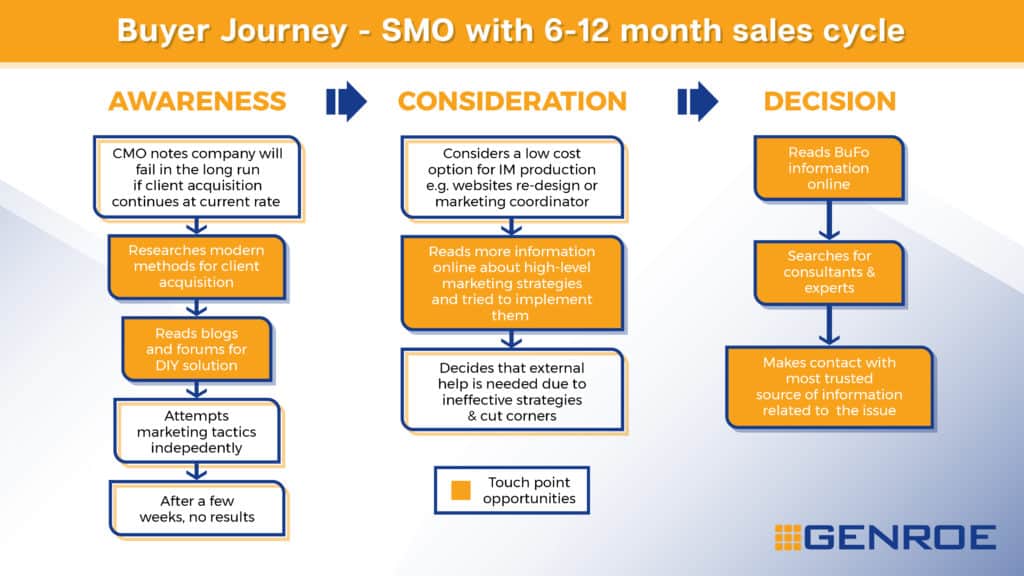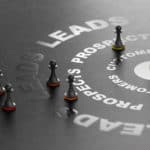The buyer’s journey is the foundation of an effective marketing funnel. Without it, you’re shooting blind and B2B marketing becomes a matter of luck rather than a series of calculated moves.
A buyer’s journey is the typical or most likely process a prospect will go through leading up to the purchase of a product or service. It involves the thought process, reactions and interactions a potential buyer may go through before they are on-boarded as a client.
With an accurate and detailed buyer’s journey, you will know;
- what prospects at the ToFu (Top of the Funnel, MoFu (Middle of the Funnel) and BoFu (Bottom of the Funnel) do,
- what they are interested in
- how to better convert them from one stage to the next of your marketing funnel
The Buyer Persona Is Step 0
To build an accurate buyer’s journey, you first need an accurate buyer persona.
A buyer’s persona is a detailed profile of your ideal buyer’s professional aspirations, concerns and demographics. This only includes information helpful to marketing, such as the media your persona reads and watches, the social media they might use, their job titles, and more.
The buyer persona is critical because it is a depiction of your most likely customer. It allows your business to better empathise and understand your customers so you can better acquire and serve them.

How do I build an accurate Buyer’s Journey?
Assuming you now have a buyer’s persona, let’s dive into building a buyer’s journey. To build one, you need to put yourself in the mindset of your buyer’s persona and find the most logical and common path that person would take to arrive at your business.
A buyer’s journey will typically start with the beginning of a problem that your business can solve. There are probably many problems that your business can solve for your customers, so start with the main service you provide.
Provide value before first contact
First contact occurs when you first discuss the problem or opportunity with a prospect directly. This does not include the first time they read one of your blogs or reach your website, nor does it include the first time they give you their email or they receive one of your emails.
First contact needs to be a one-to-one discussion with the prospective buyer. This usually occurs during the decision stage of the marketing funnel.
By the time first contact occurs, the prospect’s problem or opportunity has likely evolved past their first consideration. So when you start the buyer’s journey, the problem will look different to when you first approach it with a new client.
With that in mind, the premise of creating an accurate buyer’s journey is to discover all the ways you can indirectly make contact with the prospect so you can make a positive impression before first contact occurs. This takes the form of blogs, social media, webinars, eBooks and all the other helpful and educational resources you can provide in your area of expertise.
The types of resources you provide in each stage of the buyer’s journey will differ in language, style and content. So understanding the psychology behind each stage will help you create more effective content.
The buyer’s journey is separated into three main stages. Each stage has been highlighted below along with their unique identifiers.
Stage 1: Awareness: Your prospect realises they have a problem
Identify need – This is when your prospects become aware of their challenges or an opportunity they want to pursue. They also decide whether or not the goal or challenge should be a priority.
Research options – Upon realising that they have a challenge or an opportunity, the prospect will try to find out more about this problem and the most common options available.
Prioritise criteria – prospects decide for themselves what they find to be most important in their search, this will often be reflected in their Google search terms
To better understand a prospect during the awareness stage, you should ask yourself the following questions.
- How do prospects describe their goals or challenges?
- How do they educate themselves in pursuit of these goals or when addressing these challenges?
- What are the consequences of inaction by the prospect?
- Are there common misconceptions prospects have about addressing the goal or challenge?
- How do prospects decide whether the goal or challenge should be prioritised?
Each stage of the buyer’s journey will have its own set of questions. You could ask yourself and make assumptions, but you’re better off sending out short surveys at different stages of the journey to get answers based on reality. The answers you get could surprise you.
Stage 2: Consideration: Evaluation of available options
At this stage, your prospects have defined their problem or goal and decided that they have to act. Next they need to evaluate the different options available to them.
Brand specific research – Here’s where prospects look into finding out more about the companies they are considering. Make sure you are well equipped with reviews, testimonials and detailed product information. This can come in the form of white papers, webinars, eBooks among other resources.
Compare – By providing your prospects with educational and helpful information associated with your products and services, you make it easier for them to compare your company to your competitors. The more thorough and helpful you are with the information you share, the more likely you are to come out on top when it comes to the decision to buy.
Justify – the closer your prospect gets to the purchase, the more important it is to get buy-in from upper management. Here’s where you need to have resources targeted at owners and members of the C-Suite. This includes case studies, business cases, white papers and other high-level and strategic resources.

To better understand a prospect during the consideration stage, you should ask yourself the following questions.
- What categories of solutions do your prospects investigate?
- How do they educate themselves on the various categories?
- How do they perceive the pros and cons of each category?
- How do they decide which category is right for them?
Stage 3: Decision: Your prospect selects a solution
By stage 3, your prospects have decided what kind of solution to pursue.
Select – The mindset of your prospect at this stage is to start weighing strengths and weaknesses of different vendors, hence this is typically when the prospect makes first direct contact with you.
Purchase – The purchase process you have is critical, as poor communication and a lack of best practices resources could have your buyers backing out more quickly than when they decided to jump on-board.
Questions you should ask yourself to define the Decision stage are:
- What criteria do prospects use to evaluate the available offerings?
- When do they investigate your company’s offerings, what do they like about it compared to alternatives? What concerns do they have with your offerings?
- Who needs to be involved in the decision? For each person involved, how does their perspective on the decision differ?
- Do prospects have expectations around trying the offering before they purchase it?
- Outside of purchasing, do buyers need to make additional preparations, such as implementation plans or training strategies?
7 touch-points before a purchase
Once you have answered all the questions as thoroughly as possible. You can assess the information you have and use it to build a flow chart. The flowchart will contain two key types of information:
- Causes of problems
- Responses to problems
Responses to problems are typically where the prospect will react by searching for solutions, and this is where you come in. Look at ways you can be there when your prospect is searching for solutions. This is defined as a touch point.
The rule of thumb is that it takes 7 touch points before a prospect is ready to buy. So make sure you find those touch points and make your content readily available.
Checkout this FREE template for your Buyer Persona.





